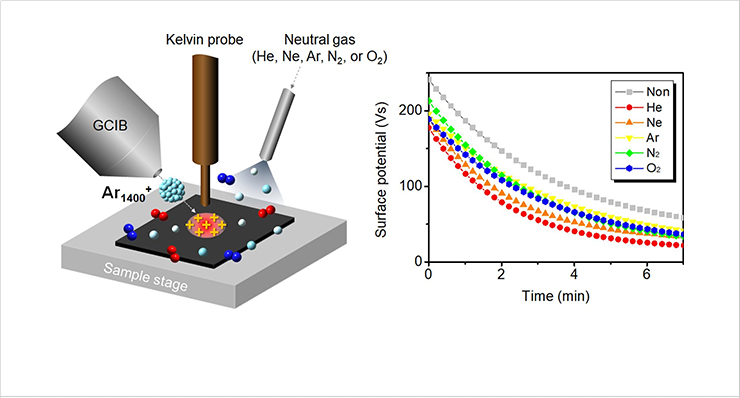Representative Research Publications
Development of Surface Charge Compensation Technology for Insulation Samples 2022 > Representative Research Publications > Research Results Home
Development of Surface Charge Compensation Technology for Insulation Samples
- Applied Surface Science / January 2022
- Aram Hong(First author), Myoung Choul Choi(Corresponding author)
Research Summary
We measured the surface potential of an insulating sample using the Kelvin probe system to investigate the neutral gas effect on charge compensation. A gas cluster ion beam was used to accumulate charges and minimize damage to the sample surface. The neutral gas effect on the surface charge of the insulating sample depends on the type of injection gas. Among the gases used in this study, Helium gas was found to have the most significant effect on the attenuation of the surface potential of the sample. We found that the decay time of the surface potential was related to the number of neutral gas particles and the mass of the gas.
Expected Outcomes
In the ToF-SIMS analysis, it is possible to make up for the low-energy electron flood gun through the development of charge neutralization technology that accumulates on the surface of the insulating sample. Neutral gas has a low energy level, so chemical damage to organic samples can be minimized. It was found that He, Ne, Ar, N2, and O2 and the type of gas could reduce the surface charge of the sample and increase the analysis ability of insulating samples, which is one of the problems of surface analysis.
Related Figures
 Fig. 1 The surface potential decay time is related to the number of collisions neutral gas particles with the polymer surface per unit area per time.
Fig. 1 The surface potential decay time is related to the number of collisions neutral gas particles with the polymer surface per unit area per time.
![[Figure 2] Fig. 2 (a) Decay time, τ (top) and (b) number of neutral gas particles, J (bottom) as a function of the mass of the injection gas.](/images/eng/sub02/2022_research_0202.jpg) Fig. 2 (a) Decay time, τ (top) and (b) number of neutral gas particles, J (bottom) as a function of the mass of the injection gas.
Fig. 2 (a) Decay time, τ (top) and (b) number of neutral gas particles, J (bottom) as a function of the mass of the injection gas.



